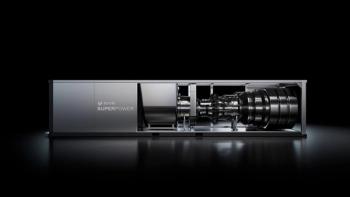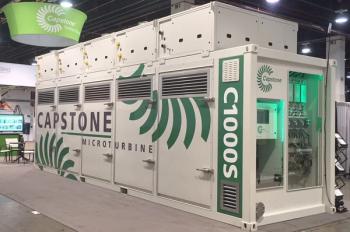
ANTISURGE PROTECTION
VIBRATION MEASUREMENTS CAN SAFEGUARD CENTRIFUGAL AND AXIAL COMPRESSORS
Surge is typically associated with fullflow reversal, and is a system-wide instability, depending not just on the compressor, but on other components of the process, such as piping, vessels and valves. It is usually accompanied by high axial and radial vibrations as well as extreme fluctuation in flow, inlet and discharge pressure and temperature.
Other unit parameters such as rotating speed or motor current are affected by surge because pressure and flow oscillations result in changes in compressor power consumption. For many centrifugal compressors, full surge cycles generally occur at frequencies between 0.25 and 3Hz (0.3-4.0 seconds per cycle) .
A surge condition can occur due to malfunction and degradation of the equipment causing process upsets in the plant, as well as plant-and-process design limitations. Existing methods of surge detection in control systems use thermodynamic measurements, such as flow, pressure and temperature, and their rates of change. For the most part, surge detection has been the prerogative of antisurge systems alone.
Many antisurge systems employed today combine the functions of surge avoidance and surge detection. Common examples include: level-based, relating the value of the operating point (or some other parameter, such as flow) of the compressor to the Surge Limit Line (SLL) setting in the antisurge controller; and rate-based, using physical evidence of surge such as rapid rate of change of various compressor parameters. However, these methods are not always reliable, due to the complex nature of surge and inadequate speed of response in process instrumentation.
Rate-based methods
A disadvantage of level-based methods is that they cannot be used as a definitive proof that surge has occurred since they depend on the operating point of the compressor crossing a controller setting. Rate-based methods, however, do use actual behavior of the compressor parameters during surge, but reliable detection remains a challenge due to factors such as signal noise in flow measurement, not being able to distinguish between surging and process upsets, and nuisance detection during signal failure.
In general, detection of rotating stall with the standard instrumentation used for antisurge control is more challenging than surge detection. Rotating stall manifests itself as pressure and flow pulsation, which tend to appear prior to the occurrence of fully developed surge. In the majority of cases, these pulsations occur at frequencies that are higher than those detectable by traditional process instrumentation. (It should be noted that while not all compressors exhibit detectable rotating stall characteristics, many machines show some type of stall behavior prior to a surge.)
Commonly used means of mechanical measurement of radial and axial vibration and axial displacement of the compressor rotor have sufficient speed of response and can show a clear indication of surge and rotating stall. That opens the door to more effective surge detection.
Correlation of the appearance of mechanical signs of surge and stall with the location of the operating point and onset of process instability can help differentiate between normal operation and surging, as an approach to detection of surge and rotating stall.
Additionally, during field testing, detection of rotating stall may help in determining the boundary of stable compressor operation without pushing the machine into fully developed surge. It may also prevent prolonged operation in the rotating stall or incipient surge region due to factors such as incorrect location of the surge limit in the antisurge system, compressor performance degradation or certain types of failure, which can tend to alter performance characteristics of the machine (e. g., foreign objects, such as failed suction strainer in the compressor gas path).
Rotating stall can be detected when the subsynchronous vibration component exceeds a threshold level, and the compressor is operating in a region of the compressor map where rotating stall is likely to occur. The region of likely rotating stall may be delineated by the minimum rotational speed of the compressor, the proximity to the Surge Control Line (SCL), and other parameters, such as compressor discharge pressure and compressor flow.
Stall and surge
If a detection signal is generated, the system will issue an alarm. Additionally, the system may counteract rotating stall and incipient surge by increasing the margin between the SLL and SCL, thereby causing the recycle valve to open, and thus moving the operating point away from the incipient region.
As the operating point moves from the rotating stall or stall region toward full surge, the transition from stall to surge may not be immediate, but as a gradually developing instability or incipient surge. Since rotating stall characteristics are typically present in the incipient surge region, incipient surge may be detected by a rise in subsynchronous radial vibration as the operating point moves toward surge.
Rotating stall may not be detectable if the region between rotating stall and surge is small. Overall, data collected from a number of field tests show that a significant number of units experience a visible rise in subsynchronous vibration prior to full surge.
If the machine enters full surge, a flow reversal may take place, resulting in a shift in axial forces acting on the compressor. In a multi-section machine, the effects of surging of one of the sections may not translate into significant axial movement, particularly if the section consumes much less power than other sections.
Axial movement
However, in most cases, surge is accompanied by significant axial movement up to the full thrust bearing clearance and a rise in the low frequency component of radial vibration high enough to cause an alarm on the machine.
Subsynchronous vibration, therefore, can be used to identify rotating stall, while thermodynamic or process measurements lack an adequate speed of response to do so. Identifying rotating stall can facilitate field testing of the units for the location of surge and stall, since testing can be stopped upon the appearance of subsynchronous vibration prior to full surge. This methodology may correctly identify SLL and SCL during commissioning thus enhancing turbomachinery protection and increasing the compressor’s operating envelope.
Increase in axial vibration, as well as in low-frequency radial vibration, indicates the likelihood of surge or severe stall. These indications can augment existing surge detection algorithms, increasing their reliability. Using axial and radial vibration to identify surge can also help differentiate between surge and process disturbances or signal failures. This has the benefit of making detection less sensitive to the selection of threshold settings for rates of change.
There may, of course, be several combinations of signals required to detect surge based on the specific application. Theoretically, at its initiation, full surge should show a simultaneous and rapid decrease in the flow and discharge pressure of the compressor.
In some cases, changes in suction pressure are larger and faster than those of the discharge pressure. For variable-speed units driven by steam and gas turbines, rotating speed can undergo large changes during a surge cycle, whereas for constantspeed units that are induction-motor-driven, motor power or current tend to have large fluctuations.
To increase reliability, therefore, surge detection should be based on a combination of signals, rather than just one signal, and both mechanical and thermodynamic signals should be used (Figure 1). This eliminates nuisance activation, and limits the opportunity for undetected surge.
Authors
Serge Staroselsky is an Engineering Manager for GE’s Control Solutions, within GE Measurement & Control, a GE Oil & Gas business. He has more than 25 years experience in the turbomachinery and compressor control industry, and has been at GE for eight years.
Mel Maalouf P.E. is a Systems Applications Engineer for GE’s Bently Nevada, within GE Measurement & Control. His 20-year background includes sensor development, field machinery diagnostics services and systems engineering for the energy industry. GE has a patent pending on combining mechanical and process data for stall and surge detection. For further information, visit www.ge-mcs.com.
Newsletter
Power your knowledge with the latest in turbine technology, engineering advances, and energy solutions—subscribe to Turbomachinery International today.





